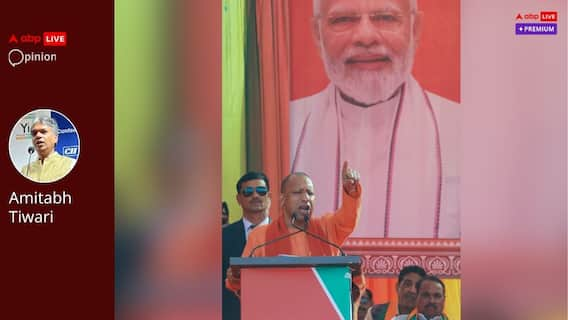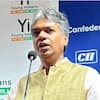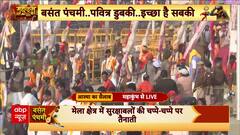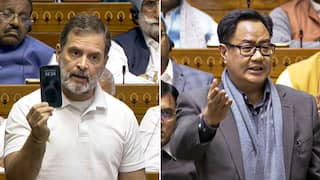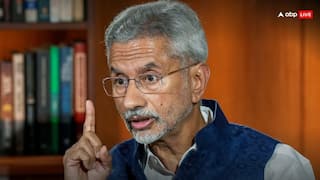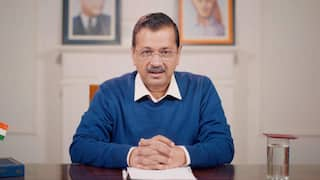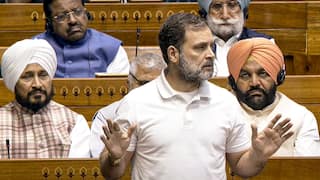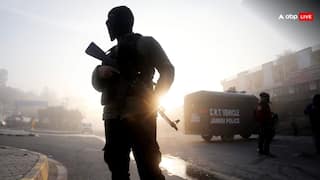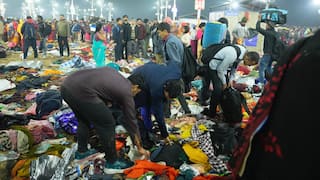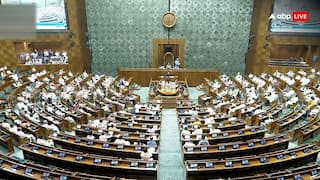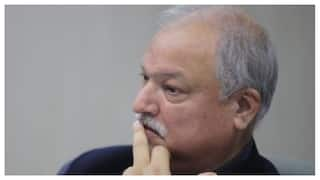Explorer
More Smiley than Bond: Will Mossad/CIA help India tackle ISI?

Jerusalem: National Security Adviser Ajit Doval shake hands with Israeli Prime Minister Benjamin Netanyahu
at his office in Jerusalem. PTI Photo(
A Desk is a dangerous place from which to view the world- John Le Carre
Ajit Doval, India's National Security Adviser (NSA), once a spy himself, is unassuming and bespectacled.
To look at, he is much more John Le Carre's George Smiley than Ian Fleming's James Bond.
Doval, circa 2017, has the implicit confidence of Prime Minister Narendra Modi, shadowing him, for example, on his recent and crucial bilateral visits to the US, Israel, and the broader based G20 Summit.
The NSA is said to be crafting an elaborate jigsaw, an altogether more robust foreign policy for India.
One beyond the confines of the Ministry of External Affairs (MEA) juggernaut, but working in close coordination with the MEA nevertheless.
The "Doval Doctrine" is marked by a lack of fear to depart from past precedents. It is driven by security considerations, pragmatism, and bilateralism, rather than ideology, or campism of any kind.
But will it also do something about the parlous state of our intelligence apparatus, beefing it up once more, to counter, amongst others, the formidable Inter-Services Intelligence (ISI) of Pakistan?
Our Research & Intelligence Wing (RAW) has been confined, for long years now, to only intelligence gathering with its budgets slashed successive times and little or no capacity to conduct covert operations.
The opportunity has presented itself, particularly now that we have decided to partner with Israel on, as the Prime Minister puts it, an "I to I" basis. And there is the bear-hug that takes in US President Donald Trump's American worldview too. Strongman Vladimir Putin, from the KGB himself, is also very close to India, and not hostile to either of India's improved relationships.
Meanwhile, RAW is today an organisation, much diminished from the days of the last muscular Prime Minister, the Joan of Arc admiring Indira Gandhi who set it up.
This, via the depredations of successive peaceniks in South Block who pulled out quite a few of its good teeth.
This form of questionable dentistry earned Prime Minister Morarji Desai a Nishan-e-Pakistan in 1990, years after his stint as Prime Minister (March 1977-July 1979) when he actually did the dirty.
Or perhaps it was, after all the intervening years, designed to be a tit-for-tat, because of India's posthumous award of its highest honour, the Bharat Ratna, for the Independence era Khan Abdul Gaffar Khan. The tall man from Pakistan's North West Frontier Province (NWFP).
Khan, also known as "The Frontier Gandhi", was a pacifist like Mohandas Karamchand, set, but to no avail, against the Partition.
More sentimental and unilateral gestures, that have always gone badly for India, involving a further diminishment of RAW, earned Pakistani accolades for Prime Minister Inder Kumar Gujral who gifted India the hugely flawed "Gujral Doctrine".
The NDA1 Prime Minister Atal Bihari Vajpayee continued to toe Gujral's softer line with his bus diplomacy, and was duly betrayed with the Kargil War.
Meanwhile, since the mid-Eighties, when the ISI was created, tasked into existence by President/Dictator/General Zia Ul Haq, Pakistan has never looked askance at its most successful intelligence agency.
General Zia, who hanged his predecessor Zulfikar Ali Bhutto, and was, much later, blown up in a plane alongside the US Ambassador, launched the infamous policy of "a thousand cuts" towards India.
Zia Ul Haq developed the new policy as a military man, who knew, and internalised, that Pakistan would not, could not, based on the evidence of 1965 and 1971, win in any conventional war with India. Not unless it vastly improved its conventional military strength.
This, however, would take resources Pakistan did not have, despite its considerable support from the US at the time, for its help against the Soviets in Afghanistan.
The need for a low-cost but smouldering revenge was stronger than ever, ever since India helped East Pakistan break away from Pakistan and become Bangladesh in 1971.
Gradually, from 1987 onwards, kindled by the American need for a "School for Jihadists", then dubbed Mujahideen, (Freedom Fighters), one was grown for them, by Pakistan, ironically, in Khan Abdul Gaffar Khan's stamping ground of Peshawar, NWFP.
A formidable ISI organisation grew, drawing on the brightest and most daring from the Pakistan Army, Navy and Air Force. It reported, via a Director-General, to the Chief of Army Staff, and the Prime Minister simultaneously.
It was structured and highly motivated, peopled by personnel with a sense of mission and Islamic purpose, quite along the same lines as the Israeli Mossad, established in 1949, just a year after Israel's independence, the latter by Israel's founder leaders, David Ben Gurion and Isser Harel.
Mossad, or "The Institute" for Special Operations, with its sister organisations, Aman (Military Intelligence), and Shin Bet (Internal Security), was determined from the start to avenge the wrongs done to Zionism and Jews, and not just those from the fledgling State of Israel.
Mossad, famously went after the perpetrators of the Holocaust in the beginning.
And ISI, initially trained by America's Central Intelligence Agency (CIA) to help counter the Soviets in Afghanistan, on the side, went after the Hindu nation, as they saw it, despite Indian professions of secularism.
It was, to the Pakistani, a Hindu majoritarian country with no place for Muslims, from which Islamic Pakistan had to be carved out, by its own founding father, Mohammad Ali Jinnah. And Pakistan wanted to sequester Kashmir as the unfinished business of Partition and in revenge for India's role in the creation of Bangladesh.
Both Mossad and the ISI have intelligence collection, covert operations, and counterterrorism in their writ, just as a full-fledged RAW and its allied organisations should.
By 1991, the ISI was ready to strike Kashmir, and the sub-continent in general.
With regard to India, the ISI has been devastatingly effective throughout, with hundreds of successful operations that go on to this day.
Pakistan has successfully deployed, via the ISI, a large number of low-cost operatives and trained terrorists, both directly, and through a number of highly skilled terrorist organisations it has nurtured, such as the Lashkar-e-Toiba (LeT), the Jamaat-e-Dawa, the Hizbul Mujahideen and so on. These in turn have spread their operations to Afghanistan and the West, sometimes in alliance, lately with the IS and others.
India has refused so far, particularly under Congress and UPA Governments, to develop a direct response to this covert and flexible capability, probably for fear of angering its 170 million Muslim population, in an irrational, but nevertheless true political construct to do with perceived vote-banks.
So it doggedly uses its regular armed forces/paramilitary, at considerably greater expense, and cost in soldierly lives, to counter these irregulars.
Irregulars, drawn from the poorest sections of Pakistani society, illiterate, brainwashed into suicidal missions, but backed always, by the Pakistani Armed Forces and its fire power etc.
Indian attrition involves professional soldiers and innocent civilians, in almost equal measure, because the ISI has brought the battle into almost all parts of India and strikes at will.
Our intelligence failures are legion, both due to inter-agency ponderousness, and sometimes even the good intelligence is not acted upon. However, because of intelligence cooperation between many countries India has befriended afresh, things are certainly getting better on this front.
In blunt retaliation, India engages on its borders, and along the line of control (LoC), with Pakistan, and by counter insurgency operations on its own soil. We are quite good at this, particularly when political interference is kept to a minimum.
But, as yet, we ostensibly do very little to take our striking arm across borders, though Pakistan does accuse RAW of interfering in Balochistan, Karachi, Peshawar, and other parts of Pakistan.
It may be time to change this if true, or sharply ramp it up, even if we are doing something.
Particularly as the various semi-autonomous Islamic Jihad organisations, grown up now, manned and funded from various sources, are now increasingly working on their own terms.
The Jihadists are no longer necessarily aiding the Pakistani purpose of alienating the Kashmir Valley in favour of Pakistan.
They seem more interested in working for an amorphous and moveable "Caliphate" of late. The Indo-Pakistani matrix plays a role still in their identity and violence, but not the only role.
Meanwhile, Pakistan was already working its way to becoming a nuclear power during the Z.A.Bhutto regime, aware that India under Indira Gandhi (1974 Pokhran-1), had already become one, albeit with a very small bomb.
After the Vajpayee Government went in for multiple and large underground tests in May 1998, the world was left in no doubt about India's nuclear weaponisation.
Pakistan had its own covert programme, and followed suit (1998), days later, matching the Indian tests with five of its own. So now there was declared nuclear deterrence capability on both sides, as in China too.
But global terrorism is a thing apart, both as a "tool" of state policy in some quarters, and its own broader objectives.
India has managed to highlight it diplomatically throughout the civilised world, now also affected by its ravages on a regular basis.
The problem is that its financiers now criss-cross allies and enemies alike. So, for a habitual victim of terror like India, we can no longer keep afloat pacifist notions with their roots in Gandhian non-violence.
We have to get ourselves ready to hit deep into the enemy citadels, in a self driven manner, with plausible deniability wherever necessary, because most countries have their own terrorist problems to deal with now.
We can be sure there will be no gratuitous condemnation from other nations, as the September 2016 "Surgical Strikes" into PoK have shown.
Mossad and the CIA, now that we are better friends of theirs than Pakistan or China, for the first time, can teach us how, and sell us the latest weapons.
A revamped RAW and its allied structures, freed of political tethers, will not be found wanting.
We draw our elite Black Cat Commandos, trained in anti-insurgency on home turf, from an inter-services pool already.
How much further is it conceptually to develop a covert strike arm that can hit deep into the innards of the enemy?
And then there are foreign operatives to be trained, for being allied to our objectives, but less conspicuous in their own backyards. Balochis, Sindhis, Chinese, Pathans, Arabs, Afghans, all looking towards India for leadership.
If China can harass us by training and arming the Maoists and the North Eastern insurgents, and the international jehadists can try to addle our 170 million Muslims, how long before we develop the capacity to hit back?
The Doval Doctrine is said to see all this in its compass. It is therefore time for India to not just develop its armed forces and paramilitary, on land, sea, and air, but be covert battle ready too.
(Gautam Mukherjee is a commentator on politics, economics and policy. His twitter handle is @gautammuk)
Disclaimer: The opinions, beliefs and views expressed by the various authors and forum participants on this website are personal and do not reflect the opinions, beliefs and views of ABP News Network Pvt Ltd.
Follow Blog News on ABP Live for more latest stories and trending topics. Watch breaking news and top headlines online on ABP News LIVE TV
View More
Advertisement
Advertisement
Advertisement
Advertisement
Trending News


Saswat PanigrahiSaswat Panigrahi is a multimedia journalist
Opinion






